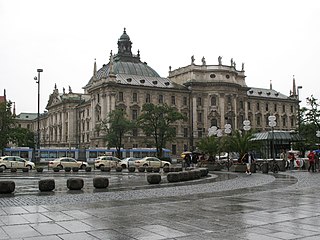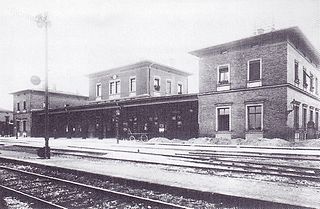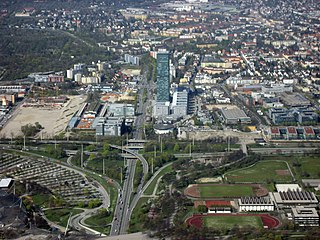
The Munich S-Bahn is an electric rail transit system in Munich, Germany. "S-Bahn" is the German abbreviation for Stadtschnellbahn, and the Munich S-Bahn exhibits characteristics of both rapid transit and commuter rail systems.

The Munich U-Bahn is an electric rail rapid transit network in Munich, Germany. The system began operation in 1971, and is operated by the municipally owned Münchner Verkehrsgesellschaft. The network is integrated into the Münchner Verkehrs- und Tarifverbund and interconnected with the Munich S-Bahn. The U-Bahn currently comprises eight lines, serving 96 stations, and encompassing 103.1 kilometres (64.1 mi) of routes.

Marienplatz is a central square in the city centre of Munich, Germany. It has been the city's main square since 1158.

Stachus is a large square in central Munich, Bavaria. The square was officially named Karlsplatz in 1797 after the unpopular Charles Theodore, Elector of Bavaria. Munich natives seldom use that name, calling the square instead Stachus, after the pub Beim Stachus, once owned by Eustachius Föderl, that was located there until construction work for Karlsplatz began. Even the U-Bahn and S-Bahn announcements use the unofficial name.

Munich East station is a railway station in Munich, the state capital of Bavaria, Germany. It opened as Haidhausen station in 1871 on the new Munich–Mühldorf and Munich–Rosenheim railway lines. The station is operated by DB Station&Service, a subsidiary of Deutsche Bahn AG, and is classified as a Category 1 station, one of 21 in Germany and two in Munich, the other being München Hauptbahnhof. It is the city's third interregional station besides München Hauptbahnhof in the city centre and München-Pasing in the west.

Laimer Platz is an U-Bahn station in Munich on the U5 line of the Munich U-Bahn system.

Candidplatz is an U-Bahn station in Munich on the U1 line of the Munich U-Bahn system. The station is named for the Flemish mannerist painter Peter Candid, who entered employ in Munich in 1586, producing notable artworks for the Munich Residenz. The station is notable for the decorative scheme applied to the outer walls, which evoke a rainbow.

Mangfallplatz is an U-Bahn station in Munich on the U1 line of the Munich U-Bahn system. Opened on 9 November 1997, it is the southernmost station on the line.

Aidenbachstraße is an U-Bahn station in Munich on the U3.

Karl-Preis-Platz is a Munich U-Bahn station on line U2. Since 12. December 2011 it is also used by the booster line U7 in the morning.

Messestadt-West is a Munich U-Bahn station on line U2.

Königsplatz is an U-Bahn station in Munich on the U2 line of the Munich U-Bahn system. It is located in the Maxvorstadt district.

St.-Quirin-Platz is an U-Bahn station in Munich on the U1 line of the Munich U-Bahn system.

Thalkirchen-Obersendling-Forstenried-Fürstenried-Solln is the 19th borough of Munich, Germany, comprising the extreme southern part of the city on the west bank of the river Isar. After the administrative reform, the boroughs Thalkirchen-Obersendling-Forstenried and Solln were incorporated, thus forming the new borough. It comprises 17.7631 square kilometres and has a population of 96.714 residents.

München Süd is a disused railway station and a railway goods station in the Munich borough of Ludwigsvorstadt-Isarvorstadt. The train service was withdrawn on 1 July 1985; in 2005 the last buildings were demolished to make room for office buildings.

The Munich tramway is the tramway network for the city of Munich in Germany. Today it is operated by the municipally owned Münchner Verkehrsgesellschaft and is known officially and colloquially as the Tram. Previous operators have included Société Anonyme des Tramways de Munich, the Münchner Trambahn-Aktiengesellschaft, the Städtische Straßenbahnen and the Straßenbahn München.

The Nuremberg tramway network is a network of tramways forming part of the public transport system in Nuremberg, a city in the federal state of Bavaria, Germany. The system reached the neighboring city of Fürth from its opening year to almost a century later when construction of the U1 subway line led to the withdrawal of tram service to and within Fürth. During that era and referring to it historically in literature or nostalgic activities, the system was known as “Nürnberg-Fürther Straßenbahn“. For example, a local association dedicated to preserving the history and heritage of the tram network as well as old rolling stock calls itself “Freunde der Nürnberg-Fürther Straßenbahn“ The system is planned to cross the municipal boundaries of Nuremberg once more, if and when the extension to Erlangen and from there to Herzogenaurach dubbed "Stadtumlandbahn" opens.

Moosach[ˈmoːsax] is the 10th northwestern district of Munich, Bavaria, Germany. It is sectioned in the urban districts Hartmannshofen, Pressestadt and Borstei.

Ramersdorf-Perlach is a borough of Munich. It is located south-east of the city center and is the most populous of Munich's boroughs with a population of about 116,000. It consists of the five districts Ramersdorf, Balanstraße West, Altperlach, Neuperlach and Waldperlach.

Englschalking is a district of the Bavarian capital Munich and belongs to the district 13 Bogenhausen.





















